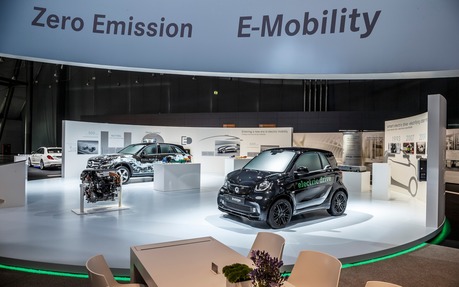Mercedes-Benz Goes Green: Electric powertrains in Every Class!
The German automaker recently summoned automobile journalists to a presentation officially called “Road to the Future,” but nicknamed “Tech Day.” This program showcases the vehicles and technologies that will forge the future of Mercedes-Benz products.
Just like many other manufacturers, Mercedes believes that the future of automobiles will be defined by various drivetrains designed to suit buyers’ specific needs. No less than $7 billion will be invested in green technologies in the next two years alone. At the end of this period, every Class will include a fully electric version and different drivetrains for different drivers.
- Also: 2017 Mercedes-Benz C-Class Cabriolet: Mercedes’ Top-Down Approach
- Also: 2017 Mercedes-Benz SLC: A Sweeter Taste
The manufacturer’s overall strategy breaks down into four roads:
Optimization of diesel and gasoline engines
In a perfect world, one single technology would replace the gasoline engine globally in the short term. But since that is unlikely, Mercedes will continue to develop new technologies to improve its models’ energy efficiency and emissions, which represents the fastest way to lower global emissions. For several years already, we have seen reductions in engine displacement and the widespread use of turbocharging.
The big innovation at Mercedes is the arrival of two new technologies that assist the gasoline engine to reduce fuel consumption. The first, known as RSG, is a belt-driven starter generator that replaces the alternator. It helps the engine when starting or accelerating, at the same time generating a current whenever possible.
The second combines a starter and a starter generator integrated into a small electric motor. These two components closely imitate a hybrid engine by helping the gas engine in various conditions, thereby reducing effort and fuel consumption. It becomes even more efficient when paired with a 48-volt power supply, since the electrical power allows for superior supply, similar to that of hybrid cars. The advantage of this system is its lower cost compared to traditional hybridization.
Hybrid versions throughout the lineup
One of the most efficient and fastest ways to reduce fuel consumption is hybridization and, in particular, plug-in versions: you get significant reductions without compromising operating range. Mercedes-Benz is making significant strides this year by introducing the S 500 e, an S-Class sedan able to go more than 50 km in fully electric mode. The manufacturer is planning on applying these new advances to all of its models while continuing to develop higher-performance batteries by way of its Accumotive division. Since the premium for this type of vehicle has very often made them less attractive than conventional versions, cost will be key.
Electrifying the whole lineup
Mercedes-Benz was one of the first manufacturers to make the leap to electric cars with its smart fortwo electric drive. On the market since 2007, the smart fortwo’s fourth generation will be released this year. Very shortly, the group will offer more than a dozen all-electric versions, spanning each and every Class.
During the seminar, Mercedes unveiled a brand new modular platform that can be extended and modified to accommodate different electric vehicles. It will be the backbone of the coming versions, serving as a basis for the quick launch of several new electric variants in all segments. We’ll see the first vehicle with this platform at the next Paris Auto Show and rumour has it that it will be the S-Class.
Hydrogen
The main drawback to electric cars is not only operating range but also the time it takes to recharge. Pairing an engine with a hydrogen fuel cell battery helps overcome the problem since it takes about the same time to fill up with hydrogen as it does to fill a tank of gas. A few minutes later, you’re good to go for 500 km with a 100% electric vehicle.
The manufacturer is preparing to launch the world’s first plug-in hydrogen model, the GLC F-Cell, based on its compact SUV. It will also have 9-kW battery pack located at the rear of the vehicle that will provide an additional 50 km of range in all-electric mode. Two compact carbon fibre tanks are housed under the hood in place of the engine. They can be refilled in two minutes at a service station and can contain enough hydrogen to supply the fuel cell for more than 500 km.
Of course, some will argue that you need energy to produce hydrogen, to which the manufacturer responds that emissions will be greatly reduced and, more importantly shifted outside major urban centres. It’s a little like when people say that electricity used for supplying electric vehicles is produced using highly polluting technologies: infrastructure is an ongoing challenge.
Basically, over the next few years, Mercedes-Benz will launch several new technologies to diminish harmful vehicle emissions. Determining which of these technologies suits you best will depend on your needs – and there will be something for everyone.
